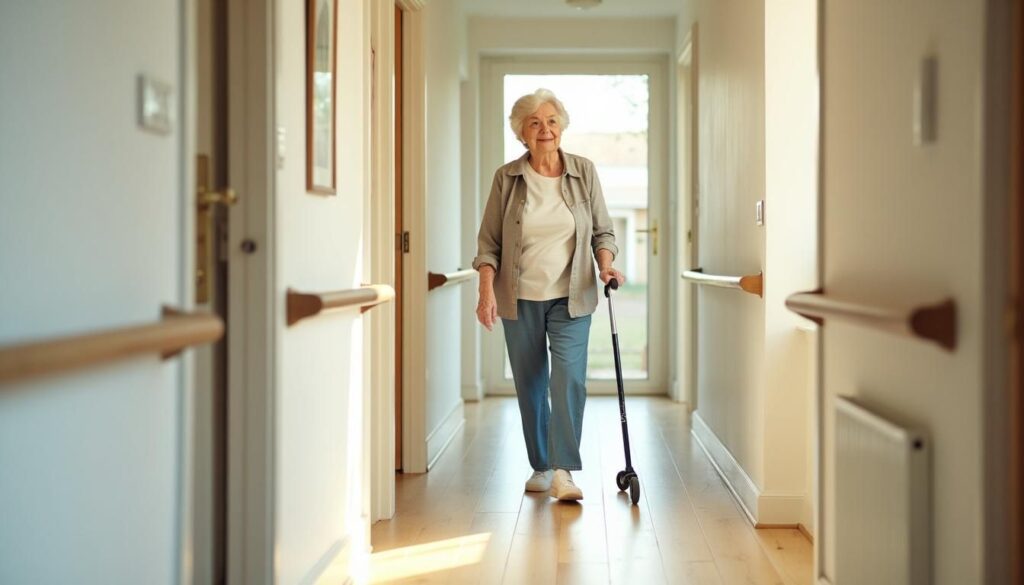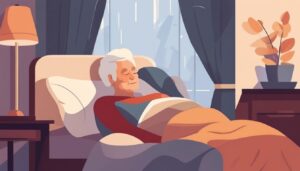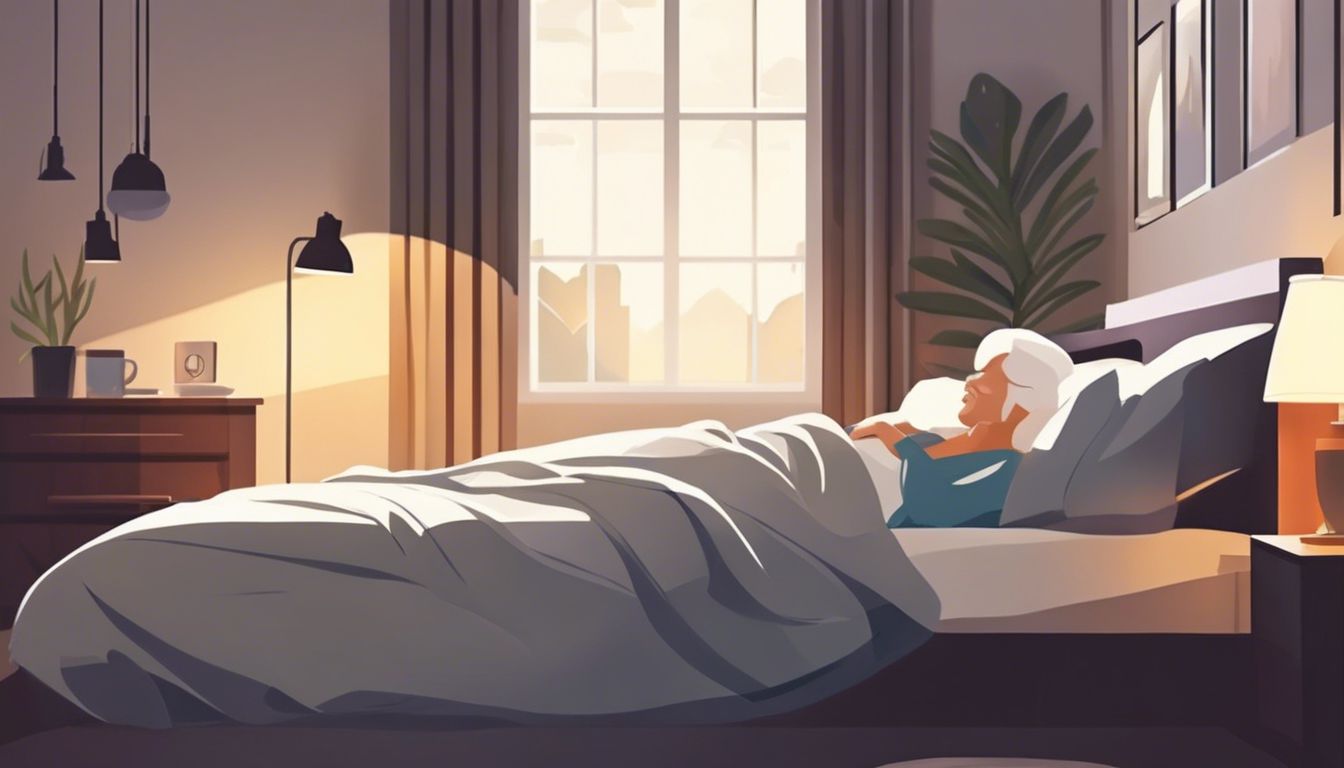Seniors often face challenges with mobility and independence at home. In fact, 77% of Americans over the age of 50 prefer to stay in their own homes as they age. This blog will guide you through essential home modifications—to make life safer and easier for seniors.
Keep reading to learn how simple changes can transform daily living!
📋✅
- Grab bars and handrails help seniors move safely at home. Install them in bathrooms, staircases, and hallways.
- Ramps provide easy access for wheelchairs and walkers. Use non-slip surfaces and sturdy handrails.
- Smart home tech like automated lights and emergency systems boost safety. They make daily tasks easier.
- Upgrading to non-slip flooring prevents falls. Choose materials like rubber or vinyl for better traction.
- Wider doorways improve mobility for wheelchair users. Aim for 32 inches wide with lever handles.
Understanding the Importance of Home Modifications for Seniors

Millions of seniors want to stay in their homes. As of August 2022, 77% of Americans over 50 prefer to age in place. Home modifications make this easier and safer for them.
In-home care is getting more expensive—10.2% higher than assisted living costs in 2021. Changing the home can help reduce these costs by preventing falls and improving mobility. Features like grab bars, wider doorways, and ramps are essential for wheelchair users and those with reduced strength or arthritis.
Using smart home technology also boosts independence. Lighting automation improves visibility at night. Emergency response systems provide quick help during accidents or health crises.
Essential Home Modifications to Enhance Senior Mobility
Make small changes at home for more freedom… Install safety features that help seniors move with ease.
Installation of Grab Bars and Handrails
Handrails and grab bars make homes safer for seniors. They offer support and prevent falls.
- Install Grab Bars in Bathrooms: Set up grab bars near toilets and in showers. This helps seniors maintain balance. It also assists them in moving from sitting to standing positions.
- Add Handrails on Staircases: Place handrails on both sides of staircases. This provides extra support for climbing stairs. It enhances stability and reduces the risk of falls.
- Put Handrails in Hallways: Install handrails along long hallways. These provide a steady guide for senior mobility.
- Place Grab Bars Near Kitchen Counters: Position grab bars near kitchen sinks and counters. This offers extra support while cooking or cleaning.
- Set Up Handrails Near Exits: Add handrails by doorways and exits. This makes it easier for seniors to go outside safely.
Setting Up Ramps for Wheelchair and Walker Access
Seniors need easy ways to move in and out of their homes. Ramps can help those who use wheelchairs or walkers.
- Choose the Right Material: Wood, aluminum, and concrete are common materials. Wood ramps need more care. Aluminum ramps last longer and need less upkeep. Concrete ramps are sturdy but cost more.
- Measure the Slope: The slope should be gentle. For every inch of height, there should be 12 inches of ramp length. This makes it safe and easy for wheelchairs.
- Install Indoors and Outdoors: Place ramps at all entrances, including back doors and garages. Indoor thresholds may need small ramps too.
- Add Non-Slip Surfaces: Use non-slip materials on the ramp surface to prevent falls. Rubber mats or textured paints work well.
- Ensure Sturdy Handrails: Install handrails on both sides of the ramp for support. They help with balance and safety.
After setting up access ramps, improving bathroom safety is also crucial for seniors…
Upgrading to Non-Slip Flooring
Upgrading to non-slip flooring can prevent falls and enhance senior safety. Different types of flooring materials work best:
- Rubber Flooring: Soft and shock-absorbent. Reduces fall risk.
- Cork Flooring: Natural grip and padding. Eco-friendly option.
- Vinyl Flooring: Easy to clean. Slip-resistant surface.
- Low-Pile Carpeting: Offers better traction. Works well with nonskid backing on carpets.
- Linoleum Flooring: Durable. Less slippery than ceramic tiles.
Consider these flooring options for a safer home… next, let’s discuss widening doorways for better accessibility.
Widening Doorways for Better Accessibility
Making doorways wider helps seniors move around easier. This is crucial for wheelchairs and walkers.
- Ensure doorways are at least 32 inches wide. This meets ADA standards.
- Use lever handles on doors. These are easier to use than round knobs.
- Remove threshold steps between rooms. This reduces tripping hazards.
- Install pocket doors or bi-fold doors. These save space and improve access.
- Choose automatic doors for major entrances. These allow hands-free entry.
Next, let’s explore essential bathroom modifications for safety and ease…
Key Bathroom Modifications for Safety and Ease
Bathrooms can be tricky for seniors. Simple changes make them safer and easier to use… You’ll find these tips helpful!
Installing Walk-In Tubs and Showers
Walk-in tubs and showers boost safety for seniors. They make bathing easier and more secure.
- Non-Slip Mats
Non-slip mats in the shower prevent falls. They give extra grip for wet feet.
- Handrails
Handrails inside walk-in tubs provide strong support. Seniors can hold onto them while moving or standing.
- Walk-In Tubs
Walk-in tubs have a low step entry. This makes it easier for seniors to get in and out without lifting their legs too high.
- Handheld Showerheads
Handheld showerheads offer flexibility. Seniors can direct water where needed without moving much.
- Corner Seats
Adding corner seats in showers gives a place to rest. It helps those who can’t stand for long periods.
- Raised Edges
Raised edges on walk-in tubs keep water inside, reducing slippery floors outside the tub area.
- Quick-Drain Feature
Many walk-in tubs have a quick-drain feature. This speeds up the draining process, so seniors don’t have to wait long before exiting.
Each of these changes improves bathroom safety for seniors, making daily routines simpler and reducing risks of injury.
Raising Toilet Seats
Raised toilet seats reduce effort. They also help seniors maintain independence.
- Easy Installation: Most raised toilet seats fit over existing toilets. Many models do not require tools.
- Height Options: Available in various heights, usually between 2 to 6 inches. Choose the right height based on the senior’s needs.
- Added Support: Many raised seats come with grab bars or handrails. These added supports make sitting and standing safer and easier.
- Cost Effective: Prices range from $20 to $150. Affordable options are available for all budgets.
- Comfort Features: Some seats have padded sections for extra comfort. Others offer contoured shapes for better support.
- Weight Capacity: Standard models support up to 250 pounds. Heavy-duty versions can handle more weight, often up to 500 pounds.
Ensuring a safe bathroom environment improves quality of life… Raised toilet seats are a key part of this effort!
Adding Seating in Showers and Near Tubs
Adding seating in showers and near tubs provides safety for seniors. These changes help prevent falls and make bathing easier.
- Install a shower bench. It offers a safe place to sit while washing.
- Place a chair near the tub. This makes getting in and out easier.
- Use non-slip decals on the seat. This enhances safety further.
- Secure the seating firmly. Ensures it stays in place during use.
- Choose water-resistant materials. Prevents wear and tear from moisture.
These steps can significantly enhance mobility and independence for seniors at home.
Bedroom Modifications for Improved Sleep and Safety
Adjustable beds help seniors find comfortable positions for better sleep. Bed rails reduce the risk of falling during the night, keeping them safe.
Selecting Adjustable Beds for Comfort and Mobility
Selecting adjustable beds helps seniors find comfortable sleeping positions. These beds make it easier to get in and out of bed.
- Helps with Acid Reflux: Adjustable beds can raise the head, reducing acid reflux.
- Improves Circulation: Elevating legs can improve blood flow. Seniors might sleep better and feel less pain.
- Reduces Swelling: By lifting feet, fluid buildup is minimized. This helps those with leg swelling issues.
- Easier Entry and Exit: Adjusting the height makes getting in and out of bed simpler. Seniors gain independence this way.
- Customizable Positions: Different angles help find a perfect position. This aids comfort and reduces body pain.
- Remote Control Use: Most adjustable beds have remote controls. Seniors can change positions easily.
- Adds Safety: Some models come with side rails. These prevent falls during the night.
Installing Bed Rails
Bed rails can keep seniors safe in bed. They also help them get in and out of bed more easily.
- Prevent Falls While Sleeping: Bed rails stop seniors from rolling out of bed. This is crucial for their safety.
- Provide Support: Seniors can hold onto the rails to sit up or lie down. This reduces strain on their bodies.
- Affordable Solution: Most types of beds can have rails installed. Many options cost less than $100.
- Easy Installation: No need for special tools. Just follow simple instructions.
- Portable Models Available: Move them to another bed if needed. Perfect for travel or visiting family.
- Adjustable Heights: Fit different bed heights by adjusting the rail height as needed.
- Additional Storage Options: Some models come with pockets. Handy for holding remotes, glasses, or books.
Installing bed rails is a practical step to enhance senior mobility and safety at home.
Optimizing Bedroom Layout for Unobstructed Movement
Seniors need safe and easy-to-move spaces in their bedrooms. Arrange furniture to maximize space and reduce tripping risks.
- Remove clutter. Clear paths to avoid tripping hazards.
- Place the bed near the bathroom for easy access.
- Use small nightstands. They save space and hold necessary items.
- Choose low-profile beds. Easier to get in and out of bed.
- Ensure good lighting. Install LED bulbs for better visibility at night.
- Use non-slip rugs. Prevent falls with secure flooring.
- Have clear walkways. Ensure pathways are wide enough for walkers or wheelchairs.
Move to installing grab bars and handrails…
Technology Enhancements for Independent Living
6. Technology Enhancements for Independent Living: Smart home devices like voice assistants and smart doorbells make daily tasks easier—explore more ways to boost senior independence!
Integrating Smart Home Technology for Ease of Use
Integrating smart home technology can help seniors live independently. It makes daily tasks easier and safer.
- Remote Control of Lights, Locks, Appliances: Smart systems let seniors control lights, locks, and appliances with their phone. This helps them avoid moving around too much.
- Smart Thermostats Adjustable Remotely: These devices allow heating and cooling adjustments from any location. Seniors can stay comfortable without getting up.
- Voice Assistants for Daily Tasks: Devices like Amazon Echo or Google Home respond to voice commands. They can play music, set reminders, and control other smart devices.
- Emergency Response Systems: These systems call for help with one button press. They provide peace of mind in case of a fall or emergency.
- Lighting Automation for Better Visibility: Automatic lights turn on in dark areas like hallways and stairwells. They reduce the risk of falls at night.
- Smart Security Systems: Cameras and alarms that can be managed remotely improve home security. They alert seniors to unusual activity instantly.
- Smart Doorbells with Video: These devices show who is at the door via smartphone. Seniors do not have to open the door to strangers.
These technologies enhance convenience and safety for seniors living at home alone.
Emergency Response Systems
Emergency response systems can save lives. They ensure quick help during emergencies.
- Medical Alert Systems
Seniors wear a device that calls for help. It usually has a button to press in case of an emergency.
- Specialized Smoke Alarms
These alarms tell the location of the fire. This helps in making quick decisions and calling firefighters.
- Emergency Response Apps
Smartphones can have apps like Apple Watch’s SOS feature. These send alerts to family or medical services.
- Automatic Fall Detectors
These devices sense falls and send alerts without needing to press a button.
- 24/7 Monitoring Services
Many systems offer round-the-clock monitoring. Trained operators respond quickly to emergencies.
- GPS Tracking Devices
These help locate seniors who might wander off or get lost, ensuring safer mobility aids.
- Voice-Activated Assistants
Devices like Alexa or Google Home can call for help with voice commands, aiding those who can’t move easily.
- Integrated Smart Home Tech
Smart lighting and locks can be controlled remotely, enhancing safety and ease of access within the home.
- Panic Buttons
Installed around the home, these buttons provide extra security by allowing seniors to call for help from any room easily.
An effective emergency response system includes multiple layers of protection and accessibility for aging in place.
Lighting Automation for Better Visibility
Lighting automation boosts safety for seniors. It makes homes brighter and reduces the risk of falls.
- Automated Lighting – Automated lights improve visibility in dark areas. They can be controlled by smartphones or voice commands.
- Night Lights – Night lights help seniors see at night, reducing fall risks.
- Motion Sensors – Motion sensors turn lights on automatically when someone enters a room.
- Smart Bulbs – Smart bulbs adjust brightness based on the time of day.
- Voice-Controlled Lights – Seniors can use voice commands to control lighting, making it easier to operate.
- Timers – Timers ensure lights turn on and off at set times, adding convenience.
Install these technologies to make your home safer and more comfortable for seniors.
How Can Occupational Therapy Improve Daily Living Activities for Seniors with Mobility Issues?
Occupational therapists can assess seniors’ current and future needs room by room. They provide customized recommendations for home modifications and assistive technology. For example, they may suggest adding grab bars in the bathroom or widening doorways to accommodate wheelchairs.
Therapists help seniors adapt to changes in mobility. Training on using devices like stairlifts can make moving between floors easier and safer. They also offer guidance on daily tasks, such as cooking with accessible kitchen adjustments.
This support increases independence and ensures safety at home.
Financial Assistance and Resources for Home Modifications
There are various programs to help fund home modifications for seniors. Many options include government grants, insurance plans, and nonprofit organizations.
Exploring Government and Non-Profit Grants
Exploring government and non-profit grants can help with home modifications for seniors. These programs offer financial aid to make homes safer.
- USDA Grants and Loans: The USDA offers grants up to $7,500 and loans up to $20,000. This helps low-income seniors modify their homes.
- State Programs: Many states have programs that provide financial assistance. Check your local Area Agencies on Aging (AAA).
- Medicaid Waivers: Some Medicaid waivers cover home modifications. This varies by state, so check what is available in your area.
- Older Americans Act Funds: The Older Americans Act provides funds through AAA. This money can be used for home repairs and modifications.
- Non-Profit Organizations: Non-profits like Rebuilding Together help with free home repairs. They partner with local communities to serve those in need.
To ensure a safer bathroom…
Understanding Insurance Coverage Options
Original Medicare does not cover home modifications. Some Medicare Advantage Plans might help. Home modification costs may be tax-deductible. This can reduce your financial burden.
Consider options like home equity conversion mortgages or reverse mortgages for funding. Government and non-profit grants, like the Low-Income Home Energy Assistance Program (LIHEAP), also provide support…
Next, we will discuss when to hire professionals for safe and effective modifications.
Hiring Professionals for Safe and Effective Modifications
Hire certified contractors for home modifications. They ensure the changes are safe and effective.
Choosing Certified Contractors
Ensure that your contractor is certified. This guarantees they have the right skills for safe home modifications.
- Verify License and Insurance
Make sure the contractor holds a valid license. Check if they are bonded and insured for damages.
- Check References
Ask for past clients’ contact details. Speak to these clients about their experience with the contractor.
- Investigate Complaints
Look up the contractor on the Better Business Bureau website. Also, check with your local Chamber of Commerce for any complaints.
- Review Past Work
Request examples of previous projects similar to yours. Pictures or site visits can help evaluate quality.
- Written Agreement
Demand a detailed written contract outlining tasks, costs, and timeline. Ensure every detail is included to avoid misunderstandings.
- Certification Proof
Confirm that certifications from relevant bodies such as NAHB or CAPS are up to date.
- Ask About Subcontractors
Check if they use subcontractors and ensure these workers are also qualified and insured.
- Maintenance Plans
Inquire about ongoing maintenance checks post-installation for added safety assurance.
- Clear Communication Channels
Make sure you have direct ways to reach the contractor during the project for updates or concerns.
Importance of Regular Maintenance Checks
Certified contractors ensure the proper installation of medical equipment. Regular maintenance checks keep these modifications safe and functional. Inspections find problems early, preventing accidents.
For instance, grab bars can loosen over time. Fixing them prevents falls and injuries among the elderly. Non-slip flooring may wear out, losing its grip—replacing it keeps trips to a minimum.
Routine checks prolong the life of costly items like stair lifts or emergency response systems. Ensuring that ramps are stable means easier access for wheelchairs and walkers always remains secure.
Periodic inspections also mean your home stays up-to-date with current safety standards… reliable at all times! Reliable lighting automation helps seniors see better, reducing fall risks at night.
Conclusion
Home modifications boost senior safety and independence. Simple changes like grab bars, ramps, and non-slip floors make a big difference. Technology also adds to ease of use at home.
With the right adjustments, seniors can stay in their homes longer and safer.
FAQs
1. What home modifications can help prevent falls for seniors?
To prevent falls, homeowners can install better illumination, add handrails in stairways, and use transfer benches in bathrooms.
2. How can a walk-in shower enhance mobility for seniors?
A walk-in shower offers easy access—no need to step over high edges—which reduces the risk of slipping and falling.
3. Are there programs that assist with funding these home modifications?
Yes, the Weatherization Assistance Program provides rebates and tax returns to help cover costs for senior-friendly home improvements.
4. Can universal design features really make a difference?
Absolutely! Universal design includes things like reachable light switches and reliable appliances such as microwaves and saucepans—making daily tasks easier for seniors.
5. Why might some seniors consider an assisted living facility or nursing home instead of modifying their homes?
Some may choose an assisted living facility or nursing home if they need more constant care than what simple home modifications can provide… It’s about finding the best fit for their needs.









